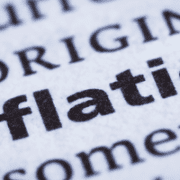Outlook for Gold 2022
Last week we published our Gold Outlook 2022 Report, our annual analysis of the gold and silver markets from CEO Keith Weiner.
In it, Keith explains the market players, dynamics, fallacies, and drivers for gold and silver. The report also includes analysis of Bitcoin and its effect on the gold market as well as inflation, interest rates and other macroeconomic factors. Last but not least, we give our price predictions for gold and silver for the year.
In this week’s episode of the podcast, we focus on just a few concepts from the article:
- The price of gold and silver in the future and why it matters
- Bitcoin – is it a safe haven asset and store of value?
- Interest rate hikes and the Fed’s predicament
- How Covid-19 has changed the incentives for gold and silver
Additional Resources
TRANSCRIPT
Ben: Welcome back to the Gold Exchange podcast. My name is Benjamin Nadelstein, marketing associate here at Monetary Metals. And today I’ll be interviewing CEO and founder of Monetary Metals, Keith Weiner on our Gold Outlook 2022 report. So, Keith, why does Monetary Metals talk about the prices of metals if that isn’t actually the main focus of the business or the gold standard in general, for that matter?
Keith: Interesting question, and something that I do think about every once in a while. I think that, number one, everybody is thinking about the price, and so it’s the elephant in the room. Number two, this being a vehicle for savings, people are always concerned if the price is going to drop too much. And what does that mean? Number three, there’s an awful lot of noise out there, either from the mainstream, the perma bears that always like to predict that gold is going to drop to $700 an ounce or something like that. It’s not that hard to find a bank or some conventional asset manager putting out a call like that pretty much at any given time. It’s like it’s dinner time somewhere or it’s cocktail hour sometime. Somewhere in the world at any given time. That’s always somewhere. Well, the same thing. There’s always some perma bear saying that. And then conversely, there’s always some perma bull saying that gold is about to go to the moon. And how do people know what’s really likely to happen? So we’ve put in all this time and energy into analyzing price and putting out something that’s been pretty accurate over the years I think
So Monetary Metals has been covering precious metals for about ten years now, and you’ve been covering that for even longer. Has the model changed at all? Is it as good now as it was then? And if anything has changed, what have you changed about the model?
So the theory is that by looking at the difference between futures price and spot price, you can discern what’s going on in the market that hasn’t changed. That’s timeless. And that same thing applied to commodities markets coming back into the 19th century and beyond. That hasn’t changed. What’s changed is that I think it was 2017 that we finally launched. We built all this software. We built a model to calculate what we call our fundamental price. So there’s all these different players that come together in the futures market. The naive assumption, and this is where many of the permabull gold analysts always looking at is that everybody is a speculator. Everybody’s betting on price, and they’re doing so with leverage. And so they always try to think all the banks are shorting, not really realizing the banks are actually arbitraging. They’re long in one market and short in another. And of course, the banks are short in the market that we collect data on, which is Comex , but long in other markets which are over the counter or completely bespoke. And so therefore, that data is not available, not reported, it doesn’t exist. Therefore, the banks are just speculators like everybody else.
But there’s our model, a number of different types of players come together in the market. Obviously there are speculators that come in the futures market using leverage. And our model is asking the question, what if the leveraged speculators, which could be pushing the price up at one time, we’re pushing the price down. What if the leverage speculators, what if the effect were backed out of the market price to get to some fundamental price? And that is where buyers and sellers of metal would be if there weren’t speculation going on in the market at the moment. And we launched that in 2017. That model has not changed. There was some interesting anomalies that came about as a result of the broken logistics system through COVID and beyond, where for quite a while we said, you know what, take the number that’s not spits out with a grain of salt because logistics made it very difficult to deliver between New York and London. And the lack of ability to deliver meant lack of ability to do the Arbitrage. So first you had some bizarre distortions, Intraday spread of $25, I think one day, and then after that, a reluctance to take the arbitrage and therefore spreads blew out became much wider than they should have been.
I think things largely sort of reverting back to normal. And I note with interest that as of last Friday, when we took the data, that’s the final data available in the 2022 Gold Market Outlook report that as of that day, for gold, the fundamental price and the market price are basically the same, which is not usually the case. Usually the speculators are either bullish or bearish. And on that particular day, not so the lines do crossover. Sometimes that happens to be one of the days that they cross over. So we talked about it first of all, I guess because it’s important, it’s out there. Number two, there’s a lot of what I call wrongful analysis or not even wrong analysis where somebody says, hey, look at the Central Bank of Ireland just bought gold. And the presumption is that bullish. And you have to look at that and say, okay, the government of Ireland bought a certain amount of gold. That is true. And that also means that tens of thousands of people for hundreds of thousands of people sold gold. Which side is right? Is it always true that the side that’s more famous is right and the anonymous 100,000 people have sold the gold are wrong?
Well, not necessarily. So gold shifts around from one part of the world to another, one vault to another. There’s inflows into the gold ETFs, which means outflows and some other vaults. And there’s a lot of analysis that likes to quote one side of that trade, form an inference or ask people to form an inference. And I think it’s important to kind of provide an antidote to say, okay, the truth is this is a two sided trade and either 100,000 people are wrong or the Central Bank of Ireland is wrong, or neither of them really know where the price is going to be tomorrow. And that isn’t the point. Meanwhile, here’s what we can say. And that’s based on looking at the spread between spot and futures.
Ben: Right. Every report goes into your predictions for the prices of gold and silver for the year. However, in this year’s report, you actually spent a lot of time on Bitcoin. Why do you think it’s so important to discuss Bitcoin in a gold outlook report?
Well, first of all, speaking of the elephant in the room in 2021 and into 2022, that has got to be the enormous elephant that everybody’s talking about. If you listen to the bitcoiners, they’re saying that Bitcoin is sucking the air out of gold or whatever analogy they might use. And I’ve written about Bitcoin over the years, often said that I prefer to write about it when it’s skyrocketing, because that neutralizes one criticism. Oh, you like to kick it when it’s down. So most of my writing about Bitcoin historically was during 2017, which was when it was skyrocketing. Last time it was skyrocketing. And Ironically or not the last one that I wrote. And I said, I’m going to put down my Bitcoin pen for a while, almost perfectly top ticked the Bitcoin market. I didn’t know it at the time. And I think in every one of those reports, most of them I said nobody knows. I don’t know what the next price move in Bitcoin is going to be, and neither does anyone else. The ones that are just predicting it’s going to go up have been right, because analyzing tide, everybody confuses lucky it was smart.
Since then, obviously, the price crashed and then it’s been building up again. And then through 2021 reached a record high at 68 $69,000. I think it’s important to contrast what Bitcoin is versus what gold is. And there’s a number of interesting arguments on the Bitcoiners I see on Twitter every day, which is basically gold is terrible, gold is lousy, gold is bad. And then when you point out that gold has some virtue, then they say, what Bitcoin is the same? I’m kind of like, okay, we’ll pick a horse. Either gold is terrible and Bitcoin is better or Bitcoin is the same as gold. You got to pick one, but not both. But I think more fundamentally, everyone kind of wants to understand what’s the safety, what’s the thing that’s going to store my value. And if that’s Bitcoin, then maybe I should sell my gold to buy Bitcoin. And then the Bitcoin will surely have to be wondering why this thing is skyrocketing, Where’s the top Bitcoin has two phases, it has the skyrocket phase and it has the Auger phase. And my point is, even during the skyrocket phase, it was not a store value.
The skyrocket isn’t storing anything. And then there’s the inevitable next phase, which while the skyrocket phase is occurring, the Bitcoin is denying that there is a second phase. Or at best, they kind of sneer at it and say, oh well, any idiot is sold then, yeah, the price went from $$20,000 to $3,000, but only the idiots sold then. Meanwhile, it’s like, wait, that’s a two thirds draw down. Only the idiots sold then, because then it went on $68,000. And so even if you bought a 20, it was smarter to hold on. Three years later, it would be a triple, ignoring the fact that money has to be stable because the whole point of money is that people are trading in and out of it, in between other goods and other transactions. You can’t say, well, my entire business is going to cease because I accepted money at a high price for money. And then when the price of money collapsed, now I’m not going to do business anymore. I’m going to hold my breath, put my business on pause, lay off my employees, stop paying my vendors and my rent and everything else, and wait for the price of money to recover and skyrockets a new price so I can continue and press resume on my business.
So is there a difference between gold and Bitcoin? What is that difference? And so I dwelled on that in this report, arguably maybe more than I should. We actually trimmed quite a bit out, and we’re going to be putting out a separate Bitcoin white paper that looks at the full economic picture of it and why Bitcoin is not sound and why Bitcoin is not money. It’s something else. It’s a zero sum or a negative sum pyramid scheme. While it’s rising, everybody’s excited. One of my broader themes in my economic work over the many years is this idea that the destruction actually occurs on the way up. So when there’s a Bull market, everyone thinks that when the Bull market finally hits the top and then crashes, that’s when the value is being destroyed. It’s the crashing. And my argument is, no, actually, the value is being consumed the whole time it’s going up. And then the crash is only a reflection of what’s already occurred. It’s the accounting catching up on paper to what’s already occurred. In reality, the same thing ultimately inevitably occurs in Bitcoin, which is a negative sum game. I’ll leave it there.
I certainly don’t want to make Monetary Metals about Bitcoin, but I think it’s important to say some of these things that you don’t necessarily hear through other sources.
Ben: So in the outlook report, you do microeconomic conditions that affect the price of gold and silver, but you also look at the macroeconomic conditions. So let’s talk about those macroeconomic conditions. You said something that I found really interesting, that certain moves by either the Federal Reserve or non monetary forces can actually lead to higher and lower prices. Really interesting point that I’d like to hear about.
Keith: So Jordan Peterson uses the term. I think he coined it. And the term is that’s a low resolution position. And he’s describing when people have this facile, simplistic or overly simplistic idea that doesn’t even really capture the nuance of what someone else said, let alone jolt to the bottom of it. And so that low resolution posion, I think is best captured. Of course, he wasn’t trying to capture a low resolution position. He thought it was the conclusion of an entire field of monetary economics. Milton Friedman famously saying inflation is always and everywhere a monetary phenomenon. What that makes people think today is that that’s printing money. First of all, it’s not printing. Secondly, it’s not money. But leaving that aside and that causes prices to rise. That causes inflation. So they see the price of and I used in the report chicken. So a friend of mine sent me a picture of a menu or a little piece of a picture of a menu from a restaurant that had some chicken dish, I don’t know, chicken wings or what it was. And the price said market. And my comment was normally you see market price listed for like Alaskan King crab and lobster and things like that, maybe in a sushi restaurant, uni sea urchin.
Market price, chicken market price, what? So there’s some crazy things going on in the chicken market. The low resolution position is to say, well, the fat is printing money, driving up the price of chicken, making it scarce, all these things, whatever. When you look at the chicken market, what you find is the farmers who grow these birds are getting paid less and the consumers who are eating them are paying more. So the price of chicken is either lower or higher depending on where in the chicken supply chain you look. So it’s a low resolution position to say price is rising. And if the price is actually falling in certain places, how do you reconcile that with Fed printing? Printing causes higher prices. How do you reconcile that with lower prices? And so the answer is this is not a monetary phenomenon. This is a function of Covid policy that especially when it comes to food processors and meat packing plants. What would they say in an abundance of caution or something like that would be the term. One guy in the meat packing plant, his kid was in the school, had a friend who had a covid exposure.
Then suddenly dad and everybody in his Department, you have to go home for two weeks in quarantine. And so meat packing plants can’t keep fully staffed. And because they can’t keep fully staffed, they can’t put out the product that they normally would put out in normal times. And so they’re not buying as many birds as they were. And that puts the farmers to grow these birds in a really bad position because some of those birds are going to reach maturity, not get bought. And then because of other regulation, it’s very hard to sell chickens. If you’re the farmer other than to a meat packing plant, those birds will have to be destroyed. The farmers are taking dreadful losses. Meanwhile, a shortage of supplies to the supermarkets and the restaurants, meaning higher prices on the other side. This is part of the COVID lockdown policy. This has nothing to do with the monetary system. And all over the world and in many, many different supply chains, we’re seeing supply chain disruption due to regulation, due to COVID, or due to just the consequences of locking down and then a whiplash of unlocking all of that rippling through various supply chains, causing shortages and problems.
Skyrocketing prices in one place, falling prices in another place. Low resolution position being, oh, yeah, money printing, higher prices.
Ben: So every year in the outlook report, you do price calls for gold and silver. But you said that this year was actually one of the hardest that you’ve ever had to make. Can you tell us why this year was specifically so difficult?
Keith: We’re at a fork in the road at the same time that the various stimuli and the benefits, if I dare use the popular misnomer of monetary stimulus, a lot of these things are kind of wearing off. And both physical stimulus and monetary stimulus have a diminishing effect. And just like a drug, imagine somebody is overtired. I don’t know. He’s a medical student, and he’s just studying and studying and studying. And then he has his rounds in the hospital and everything else. He’s dead tired after three days of no sleep, but he has to go and take another exam. So he doses up on some cocaine. Well, that’ll get him by sorta kind of. Now imagine he comes home after a full day of exams. Now it’s been almost four days without sleep. Now he’s really tired, but his girlfriend is driving up for the weekend and he wants to see her. So he takes another dose of cocaine. Well, it takes a bigger dose now with four days, 96 hours without sleep. It just takes even more dosage to prop them up. And I think we’re at that point beyond that point, at the same time that we would actually need a bigger dose to keep things continuing.
This is the moment of the Fed saying we’re going to tighten monetary conditions. We’re going to reduce our balance sheet, sell assets, and actually hike interest rates. So what we’re seeing is that at the margin price is falling. So Bitcoin proving to be a risk asset and not money. Price of Bitcoin basically collapsed. We’re seeing the price of various tech stocks, other more aggressive, high beta stock indices crashing. People think the stock market is the economy, which is not true. I’ll just leave it at that. It’s not equities that drive this it’s credit. The underlying issue is every producer is in debt up to their eyeballs, and every consumer as well. By producer, I mean the farmers, miners, the manufacturers and distributors, the truckers, the retailers, everybody’s taking on debt Kova, the ones that stayed afloat by borrowing even more. That debt also be serviced. It takes a certain amount of not just revenues. You don’t service debt with your gross revenues. It’s gross revenues minus expenses equals net profit. It takes a net profit to service your debt. What happens when people call recession, especially in the Fed dominated world, which we’ve been in for many decades, is that at the margin the debtor is unable to service his debt, which means he defaults.
His creditor sees his assets, so he’s destroyed. The equity owners are wiped out. Usually the owner is also personally devastated from that. It’s a small business. And then Meanwhile the creditor, they seize the assets and they’re trying to sell it. But this is happening across the economy, but the market for those kinds of assets. Imagine if you’re a creditor to restaurants and you’re seizing booths and benches and bar stools and deep fryers for kitchens and grills and things like that, and you and all the other creditors in the restaurant industry, across the board, and you think you’re going to go liquidate that and recover what was owed to you. You have another thing coming. There’s no bid. Nobody is starting a new restaurant in that environment. And if there was one guy starting a new restaurant, there’s so many people trying to dump that equipment that the guy is going to get great deals. He’s in a position to open a restaurant and all of that. And so the creditors themselves get under stress. The creditors begin to default. And so you get this cascading effect. Think of like Domino’s. First it’s just one little push, that’s one marginal debt or default, and then that hits the marginal creditor.
The marginal creditor is also self a debtor that debtor defaults, and then the dominoes are kept in one by one. And if that’s not contained, you have 2008, except this time it will be worse than 2008, because the solution to 2008 was to push out more credit, which means more debt. So the world is much more indebted now at lower interest rates and therefore higher asset prices than it was in 2008. And so if this really begins cascading, this is going to be quite a catastrophe. So if the world is going in that direction, then my price called for gold and silver. And by the way, gold and silver can diverge, especially in a scenario like that. My price call for gold and silver would be one thing. But if, on the other hand, if the Fed says never again, we’re not going to allow that, which they basically have said. And now we’re going to pick up a bazooka and first threatened to use it and then actually use it if we need to, if the Fed is going to get ahead of this thing and then engage in sufficient monetary stimulus and credit easing, including lowering of interest rates sufficient to get ahead of this before it really gets started.
And that would be very different macro world versus the scenario where the Fed is allowing it to happen and even dogmatically and rigidly sticking to we said we’re going to tighten and damn it, we’re going to tighten which direction the world goes in and the Fed goes in. It’s going to be a pretty different call for prices of gold and silver. So standing on that fork without knowing at this moment in time which way the Fed is going to go, I have no particular ability to be a Fed watcher or Kremlin watcher. I’m not one of those people that looks at how sick Alan Greenspan’s briefcase is or whatever the equivalent is for J. Powell. And I don’t know. I’m not sure anybody else knows either. There’s a lot of rumor and belief and theories and so forth out there. I just want to highlight one of them that I think is absolutely wrong. When people say the central banks want to reset things, the central banks are at the peak of their power right now. Why would somebody who was in power want to reset anything, as far as they’re concerned in the world is configured optimally with themselves in power at the top, number one and number two in reset.
Usually the people who used to have power don’t end up in power in the new world order that it comes after such a reset. In fact, often they lose their heads. There’s enough populist anger out there that the people that are perceived to have caused the problem get killed in the revolution that follows. I don’t think they want to reset anything. I think what they want to do is keep the gravy train going. And in addition to that, I don’t think they actually think that they are skirting with complete total collapse and the end of the system as we know it, the failure of the dollar. I don’t think they really perceive that. So I think they’re just looking at it as, okay, this is yet another one of those situations that comes up every few years. We have to turn the knobs, slide the sliders, move the levers, shift into different gears. How do we centrally plan the economy? How do we manipulate the machine to keep everything going, getting it back to the evenkeel or the permanent Plateau, the end of the credit cycle, all these terms that we use, how do we get back to the good old days?
I think that’s how they’re thinking about it. But do they perceive that we’re really at the brink right now. And I and others have written about the things that Janet Yellen and Bernanke and others, what they were saying in late 2007, early 2008. At that time, they didn’t perceive it. They said, well, subprime, it’s just subprime. Subprime is contained, blah, blah, blah, blah, blah. We have the policy tools we need. They were hubristic and a bit blind. And that isn’t really a criticism of them as people. It’s a criticism rather of the whole idea of central planning. I’m not saying these people are stupid and smarter people could have done it better. I’m saying central planning is impossible. Nobody could do it better. And we need to move beyond the cargo cult of central planning rather than saying what we need is smarter central planners.
Ben: That’s a very odd endorsement of Janet Yellen. So speaking of Janet Yellen and the Fed and Janet Yellen were messaging that they were going to hike rates. How did you know that they can only hike them slightly and only keep them there for such a short amount of time, while so many other people in the community were just oblivious to this fact?
Keith: Well, one the facile view. Well, prices are rising. Too much money printing. They’re going to have to raise rates to get ahead of it. The conventional theory, the Keynesians. And so Janet Yellen is a card carrying member of something called the New Keynesian School. So the Keynesians, the Monitor is and I think the Austrians largely all kind of share the same quantity of theory of running view, and all of them basically agreed that it’s time to hydrate. I don’t share that view. So I guess in that sense, that was easy. But looking at things as I do, I say we’ve been in this long term trend of falling interest rates at that time, 34 years as of 2015. Now, it’s been 41 years since 1981, when the interest rate peaked. And the driver for falling interest rates is that when the interest rate is above marginal productivity, that is, the marginal producer can’t afford interest rate as it is. And the demand for credit only really firms on a downtrend and interest rate. And I think the easiest way that I can illustrate this is look at and this is exactly the example that I was pointing to at that time.
And I’ll point to it again, the car makers offer a subsidy. It’s called Buy my car, and I will finance it for you at 0% for 72 months, six years of 0% money. Now, even when the Fed funds rate is 15 basis points, that is the subsidy that cost the car makers money because they have a cost to administer the program, the cost of borrowing. Of course, they’re not borrowing at the Fed funds rate. They’re borrowing at something higher than that in the bond market. And of course, they have losses when they repossess cars. Sometimes they’re smashed up or otherwise damaged. And so they have losses, they have administrative costs, they have other things. The actual cost, even if their cost of borrowing money is zero, I’m sure the actual cost to them is probably 2%. But that’s when interest rates are zero, when the interest rate goes up or the market rate goes up, the cost of that subsidy increase. And so I think it was 2017. Somewhere around there, I wrote an article looking at Ford and trying to do some back of the envelope math of how much that subsidy was costing them and comparing it to their total gross profit.
So the gross profit was five or $6 billion. The cost of that subsidy, I’m sorry, the increase. So that subsidy had a baseline cost when interest rates are zero, the increase in that cost of that subsidy when interest rates had spiked, if you want to call that little molehill spike after the Fed moved up, the increase in the cost was something like a billion and a half dollars or a quarter of Ford’s total gross profit. So the cost of the automaker is massive. Now, why would they be doing this? Because their marketing Department understands that if they were to raise the cost of interest, that they charge their customers who bought their cars to whatever the market rate would be at that moment, that’s a drop in volume would cost them even more than the subsidy. The Ford’s choice is either continue to subsidize it and lose a billion and a half or stop subsidizing it and let the cost go up and lose even more. And they did the rational thing, and they chose to lose less. And so in a centrally banked world, sometimes the choices lose more versus lose less.
So I’ll be able to see that and say it’s a marginal, there’s no demand for credit except on a downtrend rate. So if they think they’re going to hike rates, what they’re going to find is not only is there no demand for credit, but at the same time, all of the investor class is just stuff to the guilds with dollars looking for a home. And that’s why the interest rate keeps falling. It’s the dollars chasing yield. And there isn’t as much source of yield as there is demand for yield in the dollar world. This is all perversity. This is not saying anything good about the dollar world, by the way. This is one of the many perversities of how it works that you can look at it and say the interest rate is falling, the Fed is not bigger than the market. It’s the other way around. And the market is still in a falling mode. And I’d say it was even more vengeance than it was back in 2015. So we’ll see what the Fed continues to think that they can do. As we get to March. In the end of January, they were pretty boastful that they can begin tightening. If not actually hiking in March.
Keith: We’ll see as we get to March. So yesterday we had a terrible jobs report. Everybody expected jobs growth and we have jobs contraction. We’ll see how long they continue to play with elaborate high stakes game of chicken before they blink. Who knows? I can’t predict what people are going to do. I can say they can’t win this one, but I don’t know how long they’re going to cling to it before they finally pinch.
Ben: So, Keith, so much of the conventional analysis from Macroeconomics Microeconomics Gold Prices is just either wrong or, as you like to say, not even wrong. So can you give us your price calls for this year?
Keith: I can and I did. And they’re in our printed Gold Outlook report. 2022. I think I’d be better off leaving it there and encouraging people to read not just the magic number. This is the famous thing from Douglas Adams in The Hitchhiker’s Guide to the Galaxy. For anybody who’s read it, the conclusion is 42. But saying that number 42 doesn’t really tell you what the books are about. You have to read the books to see why the number 42 is meaningful. And so I would encourage people to read the report and see how we arrive at the call that we arrive at. The one thing that I can say is that the incentives to buy gold are only going up. For more on that and why I think that encouraged everybody to read the report.
Ben: Well, thanks for your time, Keith, and the great insight. As always. Make sure to check out the full Gold Outlook 2022 report in the description and subscribe to the Gold Exchange podcast. See you next time.










Leave a Reply
Want to join the discussion?Feel free to contribute!